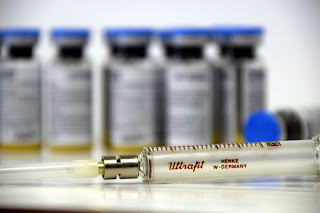Featured Post
- Get link
- X
- Other Apps
So What's In The flu shot
Traditional flu shots protect against three viruses, two influenza A viruses and one influenza B.
When you get a flu vaccine there are two options. The most available and widely used option is by injection but the nasal spray is also available although it tends to be more of an option for children.
The flu shot contains an inactive influenza virus and the nasal spray contains a weakened live virus. Neither one can cause the flu but they do trigger the bodies immune system, so it can leave some people with not just a sore arm but feeling achy or even with a low grade fever.
I'm actually one of those people who is allergic to several of the ingredients listed in the flu shot. So since I can't have it I'm very grateful for all those that do.
So a big thank you to each and every one of you who goes and get their shots.
So, what are the most common ingredients that can be found in the flu vaccine? I've included a basic list to give you an idea. (But, please if you're allergic to any of the ingredients and have never had the shot before have a chat with your Doctor. They can help you decide if it's right for you.)
Formaldehyde - It's added to inactivate toxins from bacteria and viruses in the vaccine. It's present in very small amounts so it's considerate harmless, but in large doses it can be dangerous.
Aluminum salts- This ingredient helps develop a stronger immune response against the virus in the vaccine. This allows for the inclusion of small amounts of the inactivated viruses in these vaccines.
Chicken egg protein- Vaccines are often made by growing the inactivated virus inside fertilized chicken eggs. This means that they contain a small amount of egg protein which helps the virus to grow.
There are however two types of vaccines that are egg-free.
Meat based gelatin - Most flu vaccines use pork-based gelatin as a stabilizer to keep the vaccine effective up to the moment of use.
Antibiotics - This ingredient is added to keep bacteria from contaminating the vaccine. These vaccines do not contain antibiotics that are well known to cause severe reactions. Instead, they contain small amounts of antibiotics that are considered less likely to cause reactions such as gentamicin or neomycin.
Preservatives - The preservative Thimerosal helps both to prevent and kill bacteria and fungi. It contains mercury, which can be toxic in large doses, but it's considered safe in small amounts.
There are thimerosal-free versions of the flu vaccine and spray available as well.
Stabilizers - Sucrose (sugar), sorbitol (artificial sweetener), and monosodium glutamate (MSG) are used to keep vaccines stable even when exposed to light or heat.
Polysorbate 80 - This emulsifier helps to keep the ingredients evenly distributed in the vaccine. In large doses it can cause some people to have reactions but the amount in the flu vaccine is very small. Most people can tolerate this in such small amounts and reactions are very rare.
source:
medicalnewstoday.com/articles/321207#ingredients
healthline.com/health/cold-flu/flu-shot-ingredients#ingredients
canada.ca/en/public-health/services/diseases/flu-influenza/get-your-flu-shot.html
healthlinkbc.ca/health-topics/hw121895
- Get link
- X
- Other Apps
Popular Posts
On The Search For Sensitive Skin Facial Moisturizer
- Get link
- X
- Other Apps



Comments
Post a Comment